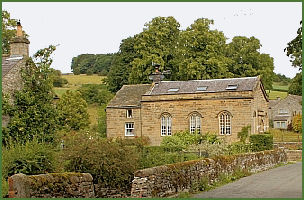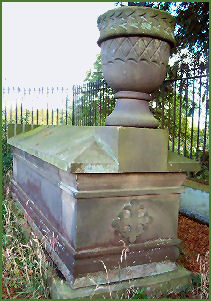Middleton-by-Youlgreave
OS Grid ref:- SK195631
 The unspoilt village of Middleton by Yougreave lies to the south west of Youlgreave, above the River Bradford.
The unspoilt village of Middleton by Yougreave lies to the south west of Youlgreave, above the River Bradford.
The village is mentioned in the Domesday book where it is recorded as being owned by Henry de Ferrers, a Norman knight who is believed to have fought at Hastings and was rewarded with vast estates in Derbyshire.
The village the visitor sees today was mostly constructed in the nineteenth century, the entire village was rebuilt by local landowner Thomas Bateman in the 1820`s after he purchased Middleton Hall and estate at the end of the eighteenth century. He also built the Congregational Chapel, now a private house, in 1826.
Middleton Castle now lies in ruins, it was constructed in the early seventeenth century as a fortified manor house. During the Civil War. Sir Christopher Fulwood recruited about a thousand men to march to Derby in support of King Charles I, but on 16th November 1643, Parliamentary troops raided the house. Fulwwod fled and it is stated that he took refuge in a cave behind a large rock in Bradford Dale, which is still known locally as `Fulwood`s Rock` but was shot by Cromwell's troops and taken to Lichfield where he later died of his wounds.
The archaeologist Thomas Bateman, (grandson of the aforementioned Thomas Bateman) lived in the village, and built Lomberdale Hall as his home.
There are some excellent walks in the area, nearby Bradford Dale is partcularly scenic. The prehistoric stone circle of Arbor Low stands just to the west of the village.
Thomas Bateman (1820-61)
 The archaeologist Thomas Bateman is buried in the village, his grave lies in a field behind the former Congregational chapel, in a small enclosure surrounded by cast-iron railings and is surmounted by a stone replica of a Bronze Age cinerary urn.
The archaeologist Thomas Bateman is buried in the village, his grave lies in a field behind the former Congregational chapel, in a small enclosure surrounded by cast-iron railings and is surmounted by a stone replica of a Bronze Age cinerary urn.
Bateman, the son of the amateur archaeologist William Bateman and Mary, nee Crompton, was born in nearby Rowsley. Following the death of his father in 1835, Bateman was raised by his grandfather, Thomas Bateman and from the age of 16 he helped run the family estate at Middleton Hall, during this time he became intensely interested in archaeology.
His first archaeological experience was to watch the demolition of a medieval church in Bakewell. He joined the British Archaeological Association in 1843 and in 1844 and whilst at an archaeological congress in Canterbury, he took part in the excavating of barrows in the surrounding countryside. The following year he excavated 38 barrows in Derbyshire and Staffordshire, earning himself the nickname "The Barrow Knight".
In 1847 Bateman published his first book, entitled 'Vestiges of the Antiquities of Derbyshire' which combined his work with that of earlier excavators in the area. He continued to excavate barrows, 50 in the period 1848–1849 and a further 22 between 1851 and 1861, when he died.
His second book was 'Ten Years Diggings in Celtic and Saxon Grave Hills in the Counties of Derby, Stafford and York', which was published in the year of his death. Many of his collections are now in Sheffield Museum, with some in the British Museum.
Nearby places of interest
Haddon Hall is an architectural gem. Dating back to the eleventh century, the hall has been described as "the most complete and most interesting house of [its] period", it is the finest example of a medieval manor house currently in existence in England.
Lathkill Dale, a Peak District beauty spot in the truest sense of the word, is one of Britain's finest limestone valleys, it is situated about 3 miles from Bakewell.
Arbor Low, sometimes referred to as ‘The Stonehenge of the North' is a prehistoric site of unique archaeological and cultural interest.
Monsal Head, a justly famous beauty spot, commands superb views down Monsal Dale and up the Wye Valley
Dovedale a dramatic limestone ravine, with its impressive rock outcrops and tranquil woodlands is arguably the prettiest and most famous of the dales in the Peak District National Park
Back to Top
